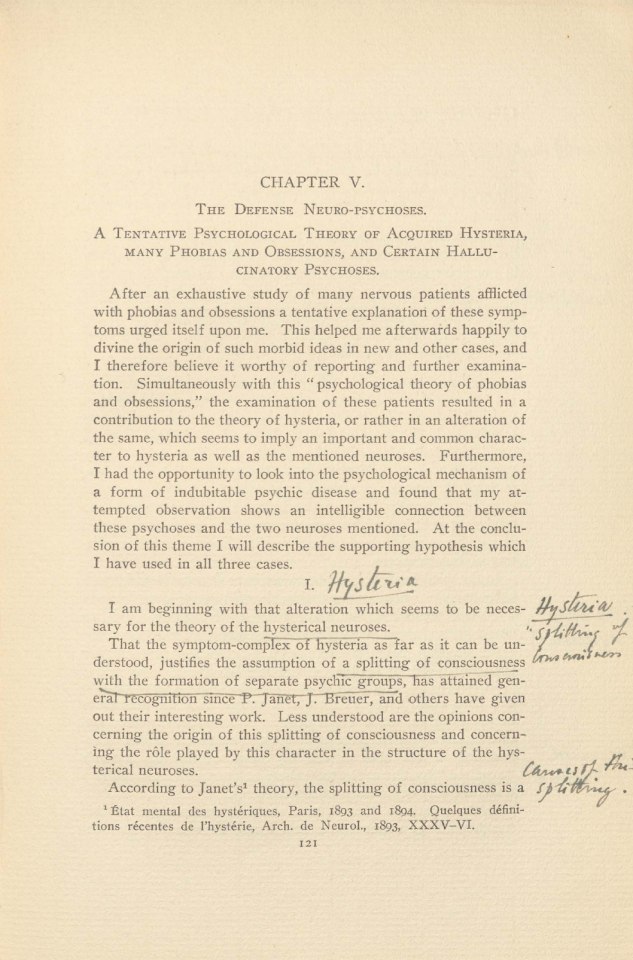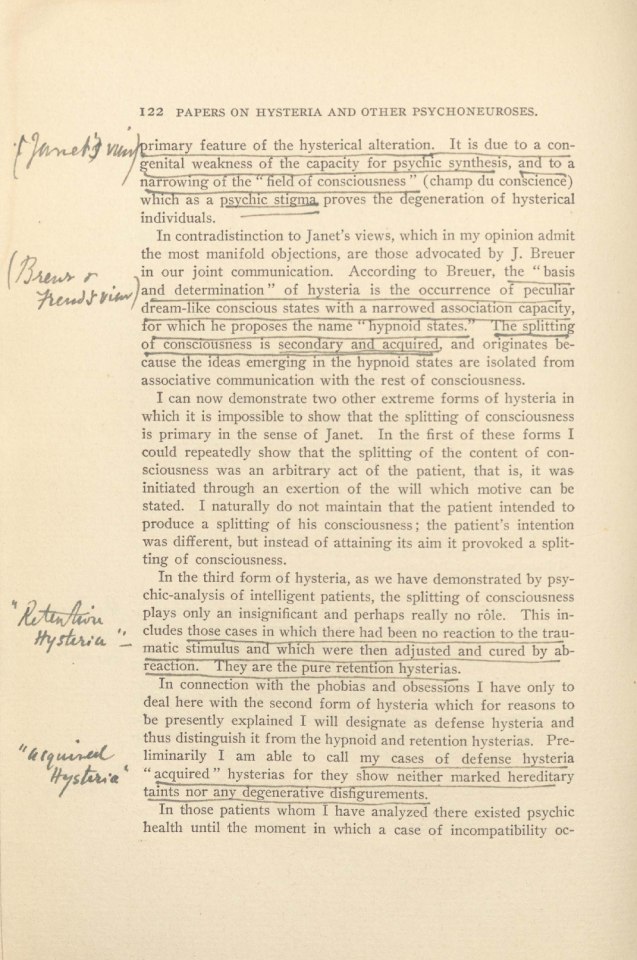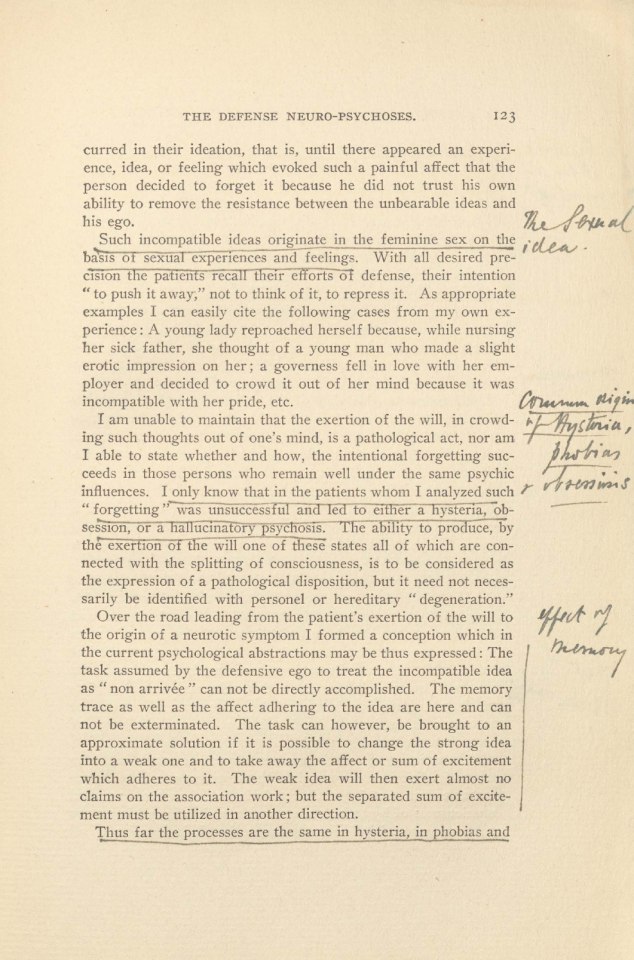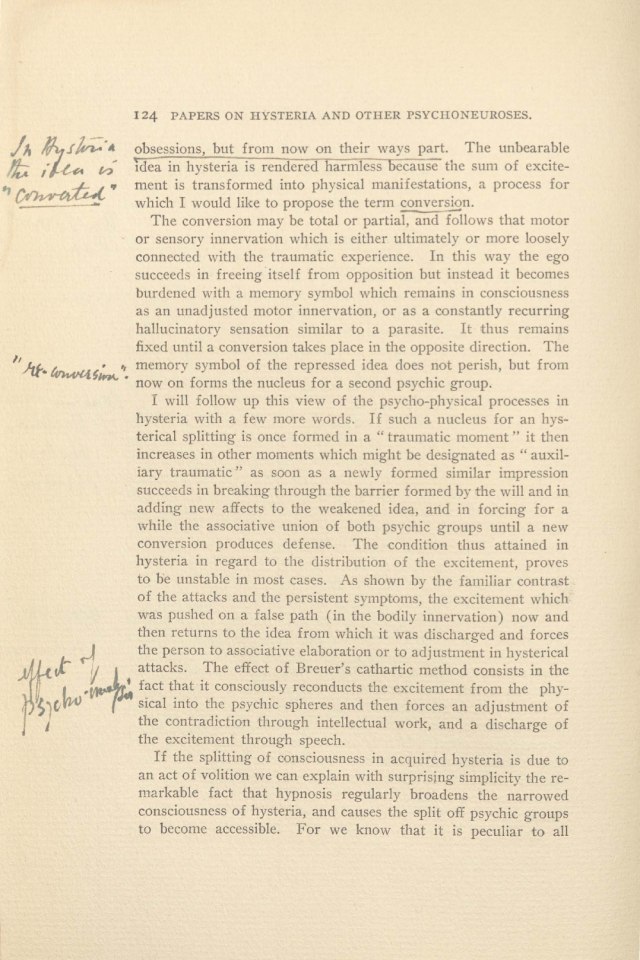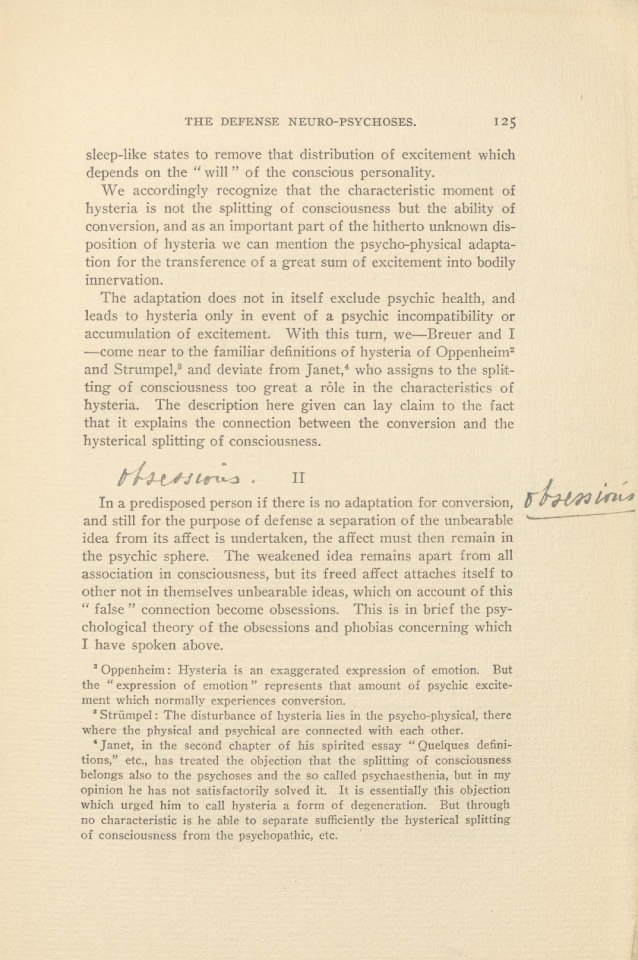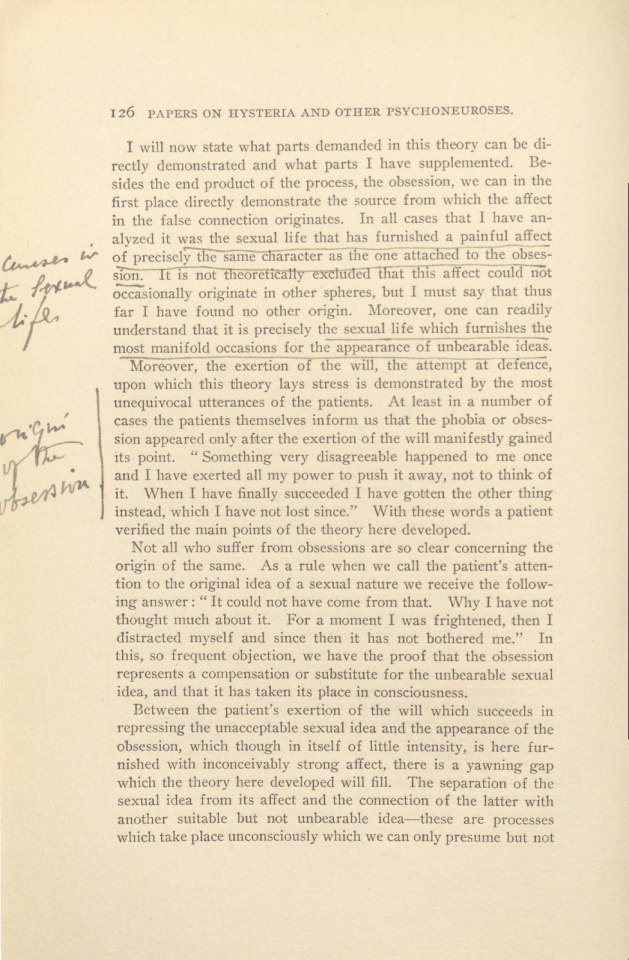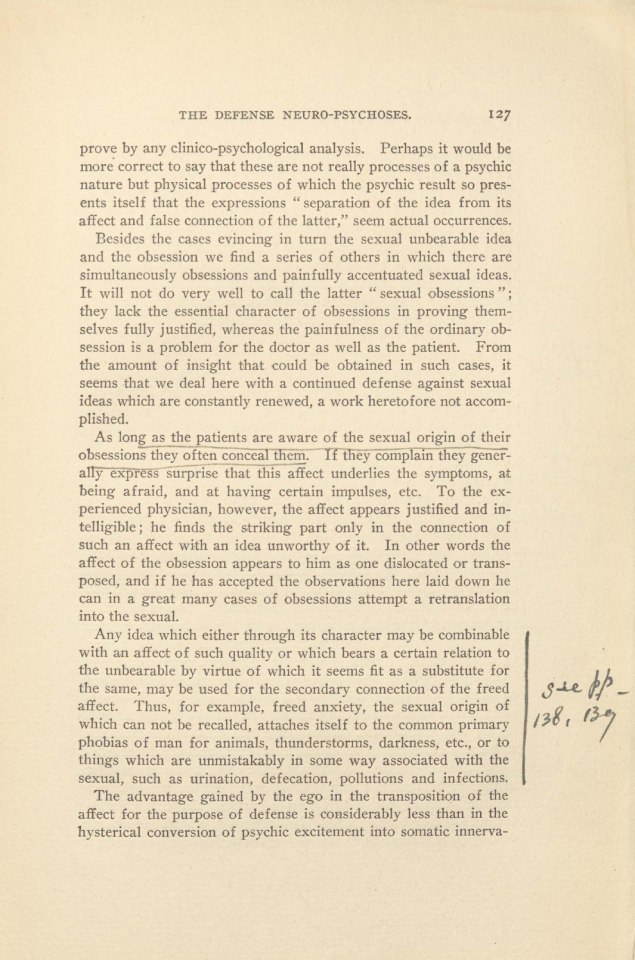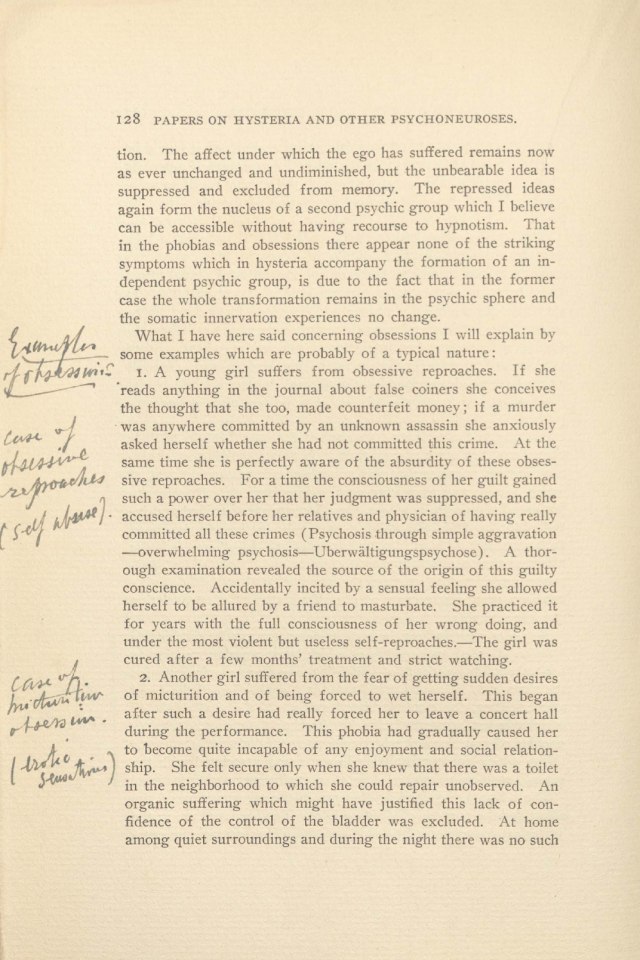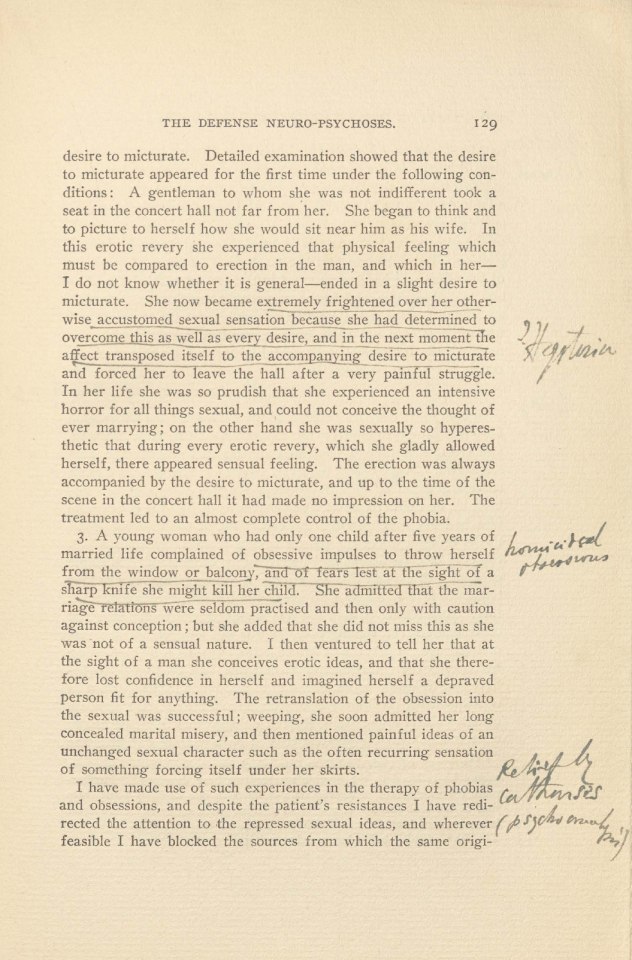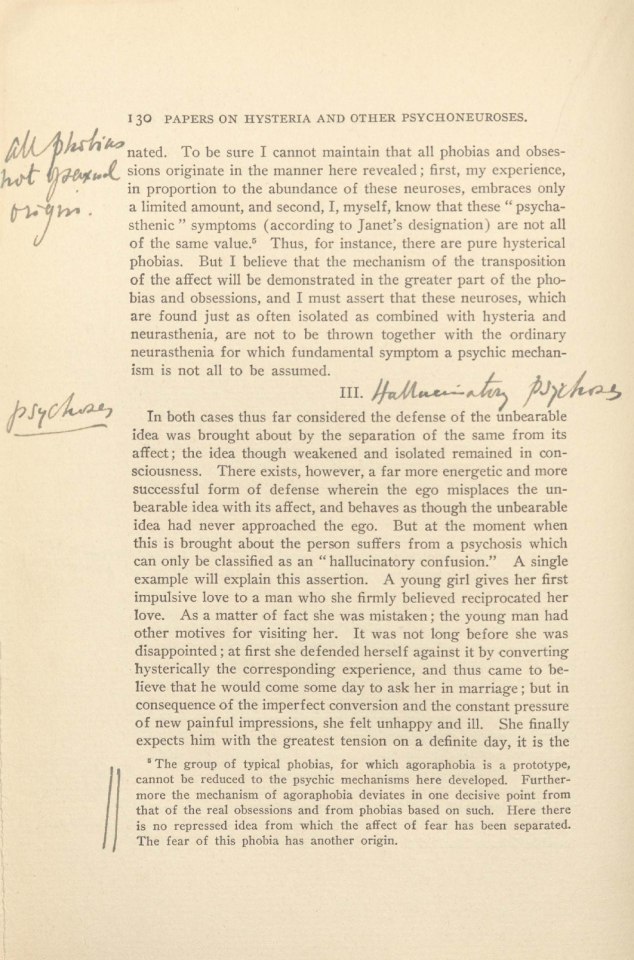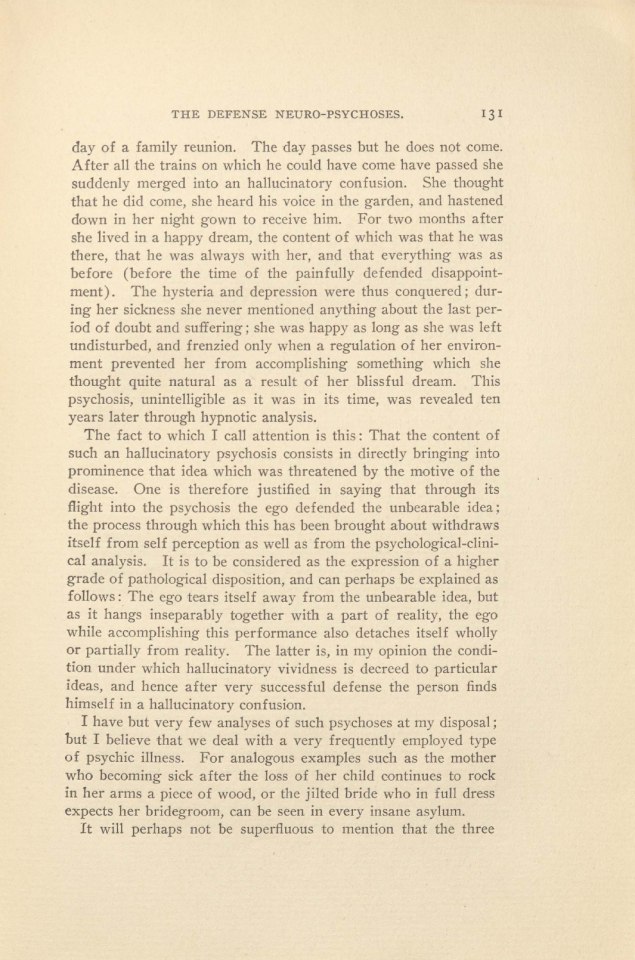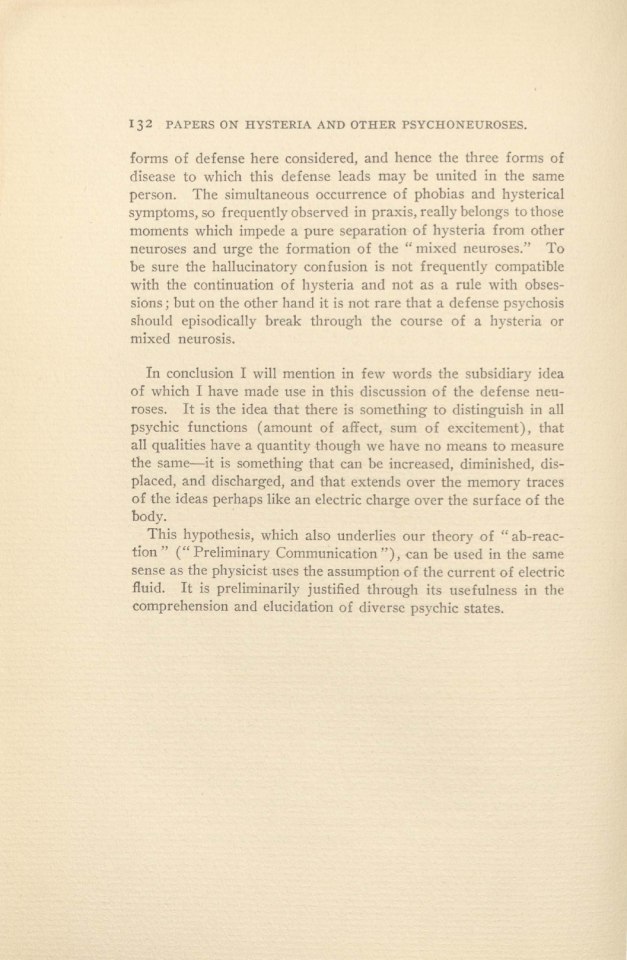S.
CHAPTER V.
THE DEFENSE NEURO-PSYCHOSES.
A TENTATIVE PSYCHOLOGICAL THEORY OF ACQUIRED HYSTERIA,
MANY PHOBIAS AND OBSESSIONS, AND CERTAIN HALLU-
CINATORY PSYCHOSES.After an exhaustive study of many nervous patients afflicted
with phobias and obsessions a tentative explanation of these symp-
toms urged itself upon me. This helped me afterwards happily to
divine the origin of such morbid ideas in new and other cases, and
I therefore believe it worthy of reporting and further examina-
tion. Simultaneously with this “psychological theory of phobias
and obsessions,” the examination of these patients resulted in a
contribution to the theory of hysteria, or rather in an alteration of
the same, which seems to imply an important and common charac-
ter to hysteria as well as the mentioned neuroses. Furthermore,
I had the opportunity to look into the psychological mechanism of
a form of indubitable psychic disease and found that my at-
tempted observation shows an intelligible connection between
these psychoses and the two neuroses mentioned. At the conclu-
sion of this theme I will describe the supporting hypothesis whichI have used in all three cases. ⑧
tr d な TOMT am beginning with that alteration which seems to be neces-
772 .
sary for the theory of the hysterical neuroses. cn る ん c pA
That the symptom-complex of hysteria as far as it can be un-
derstood, justifies the assumption of a splitting of consciousness
with the formation of separate psychic groups, has attained gen-
eral recognition since P- Janet, J. Breuer, and others have given
out their interesting work. Less understood are the opinions con-
cerning the origin of this splitting of consciousness and concern-
ing the róle played by this character in the structure of the hys-
terical neuroses.According to Janet`s theory, the splitting of consciousness is a J;
* État mental des hystériques, Paris, 1803 and 1804. Quelques défini-
tions récentes de l’hystérie, Arch. de Neurol, 1893, XXXV-VI.I21
み ザ ク ク ッ
“メ ケ
yr -S.
か み
ur r
カ ァ ッ ク ア ノ
Wystawa と
“4 tud
slave“4
122 PAPERS אס HYSTERIA AND OTHER PSYCHONEUROSES.
rimary feature of the hysterical alteration. It is due to a con-
enital weakness of the capacity for psychic synthesis, and to a
ror of the "Held of consciousness ” (champ du conscience)
which as a psychic stigma, proves the degeneration of hysterical
Tridividuals a Y eIn contradistinction to Janet's views, which in my opinion admit
the most manifold objections, are those advocated by J. Breuer
in our joint communication. According to Breuer, the “ basis
and determination” of hysteria is the occurrence of peculiar
dream-like conscious states with a narrowed association capacity,
tor which he proposes the name “ hypnoid states. e splittin
of Consciousness is secondary and acquired, and originates be-
cause the ideas emerging in the hypnoid states are isolated from
associative communication with the rest of consciousness.I can now demonstrate two other extreme forms of hysteria in
which it is impossible to show that the splitting of consciousness
is primary in the sense of Janet. In the first of these forms I
could repeatedly show that the splitting of the content of con-
sciousness was an arbitrary act of the patient, that is, it was
initiated through an exertion of the will which motive can be
stated. I naturally do not maintain that the patient intended to
produce a splitting of his consciousness; the patient’s intention
was different, but instead of attaining its aim it provoked a split-
ting of consciousness.In the third form of hysteria, as we have demonstrated by psy-
chic-analysis of intelligent patients, the splitting of consciousness
plays only an insignificant and perhaps really no role. This in-cludes those cases in which there had been no reaction to the trau-
m:atic Stimulus and which were then adjusted and cured by ab-
Om אוה TRE pure relention Tysterian, = = הר הרי ysterias.In connection with the phobias and obsessions I have only to
deal here with the second form of hysteria which for reasons to
be presently explained I will designate as defense hysteria and
thus distinguish it from the hypnoid and retention hysterias. Pre-
liminarily I am able to call my cases of defense hysteria
"acquired" hysterias for they show neither marked hereditary
taints nor any degenerative disfigurements.In those patients whom I have analyzed there existed psychic
health until the moment in which a case of incompatibility oc-S.
THE DEFENSE NEURO-PSYCHOSES. 123
curred in their ideation, that is, until there appeared an experi-
ence, idea, or feeling which evoked such a painful affect that the
person decided to forget it because he did not trust his ownability to remove the resistance between the unbearable ideas and
his ego. J^ d n al
idea -Such incompatible ideas originate in the feminine sex on the
basis of sexual experiences and feelings. With all desired pre-
Cision the patients recall their efforts of defense, their intention
“to push it away,” not to think of it, to repress it. As appropriate
examples I can easily cite the following cases from my own ex-
perience: A young lady reproached herself because, while nursing
her sick father, she thought of a young man who made a slight
erotic impression on her; a governess fell in love with her em-
ployer and decided to crowd it out of her mind because it was å
incompatible with her pride, etc. (волны, の ⑦ か
I am unable to maintain that the exertion of the will, in crowd- A
ing such thoughts out of one’s mind, is a pathological act, nor am
I able to state whether and how, the intentional forgetting suc-
ceeds in those persons who remain well under the same psychic E
influences. I only know that in the patients whom I analyzed such 7^
“ forgetting “ was unsuccessful and led to either a hysteria, ob-
session, or a hallucinatory psychosis. The ability to produce, by
thé exertion of the will one of these states all of which are con-
nected with the splitting of consciousness, is to be considered as
the expression of a pathological disposition, but it need not neces-
sarily be identified with personel or hereditary “degeneration.”
Over the road leading from the patient`s exertion of the will to Yat 7
the origin of a neurotic symptom I formed a conception which in
the current psychological abstractions may be thus expressed: The
task assumed by the defensive ego to treat the incompatible idea
as “non arrivée ” can not be directly accomplished. The memory
trace as well as the affect adhering to the idea are here and can
not be exterminated. The task can however, be brought to an
approximate solution if it is possible to change the strong idea
into a weak one and to take away the affect or sum of excitement
which adheres to it. The weak idea will then exert almost no
claims on the association work; but the separated sum of excite-
ment must be utilized in another direction.Thus far the processes are the same in hysteria, in phobias and
S.
124 PAPERS ON HYSTERIA AND OTHER PSYCHONEUROSES,
A sha obsessions, but from now on their ways part. The unbearable
ゾ a o idea in hysteria is rendered harmless because the sum of excite-
7 » ment is transformed into physical manifestations, a process for
which I would like to propose the term conversion.The conversion may be total or partial, and follows that motor
or sensory innervation which is either ultimately or more loosely
connected with the traumatic experience. In this way the ego
succeeds in freeing itself from opposition but instead it becomes
burdened with a memory symbol which remains in consciousness
as an unadjusted motor innervation, or as a constantly recurring
hallucinatory sensation similar to a parasite. It thus remains
fixed until a conversion takes place in the opposite direction. The
Atel HV memory symbol of the repressed idea does not perish, but fromnow on forms the nucleus for a second psychic group.
I will follow up this view of the psycho-physical processes in
hysteria with a few more words. If such a nucleus for an hys-
terical splitting is once formed in a “traumatic moment ” it then
increases in other moments which might be designated as “ auxil-
јату traumatic" as soon as a newly formed similar impression
succeeds in breaking through the barrier formed by the will and in
adding new affects to the weakened idea, and in forcing for a
while the associative union of both psychic groups until a new
conversion produces defense. The condition thus attained in
hysteria in regard to the distribution of the excitement, proves
to be unstable in most cases. As shown by the familiar contrast
of the attacks and the persistent symptoms, the excitement which
was pushed on a false path (in the bodily innervation) now and
then returns to the idea from which it was discharged and forces
the person to associative elaboration or to adjustment in hysterical
attacks. The effect of Breuer's cathartic method consists in the* fact that it consciously reconducts the excitement from the phy-
sical into the psychic spheres and then forces an adjustment of
the contradiction through intellectual work, and a discharge of
the excitement through speech.If the splitting of consciousness in acquired hysteria is due to
an act of volition we can explain with surprising simplicity the re-
markable fact that hypnosis regularly broadens the narrowed
consciousness of hysteria, and causes the split off psychic groups
to become accessible. For we know that it is peculiar to all”
S.
THE DEFENSE NEURO-PSYCHOSES. 125
sleep-like states to remove that distribution of excitement which
depends on the “will” of the conscious personality.We accordingly recognize that the characteristic moment of
hysteria is not the splitting of consciousness but the ability of
conversion, and as an important part of the hitherto unknown dis-
position of hysteria we can mention the psycho-physical adapta-
tion for the transference of a great sum of excitement into bodily
innervation.The adaptation does not in itself exclude psychic health, and
leads to hysteria only in event of a psychic incompatibility or
accumulation of excitement. With this turn, we—Breuer and I
— come near to the familiar definitions of hysteria of Oppenheim?
and Strumpel,® and deviate from Janet,* who assigns to the split-
ting of consciousness too great a role in the characteristics of
hysteria. The description here given can lay claim to the fact
that it explains the connection between the conversion and the
hysterical splitting of consciousness.Harris u
In a predisposed person if there is no adaptation for conversion,
and still for the purpose of defense a separation of the unbearable
idea from its affect is undertaken, the affect must then remain in
the psychic sphere. The weakened idea remains apart from all
association in consciousness, but its freed affect attaches itself to
other not in themselves unbearable ideas, which on account of this
“ false ” connection become obsessions. This is in brief the psy-
chological theory of the obsessions and phobias concerning which
I have spoken above.* Oppenheim: Hysteria is an exaggerated expression of emotion. But
the “expression of emotion” represents that amount of psychic excite-
ment which normally experiences conversion.“ Striimpel: The disturbance of hysteria lies in the psycho-physical, there
where the physical and psychical are connected with each other.* Janet, in the second chapter of his spirited essay “ Quelques defini-
tions,” etc., has treated the objection that the splitting of consciousness
belongs also to the psychoses and the so called psychaesthenia, but in my
opinion he has not satisfactorily solved it. It is essentially this objection
which urged him to call hysteria a form of degeneration. But through
no characteristic is he able to separate sufficiently the hysterical splitting
of consciousness from the psychopathic, etc. |S.
126 PAPERS ON HYSTERIA AND OTHER PSYCHONEUROSES.
I will now state what parts demanded in this theory can be di-
rectly demonstrated and what parts I have supplemented. Be-
sides the end product of the process, the obsession, we can in the
first place directly demonstrate the source from which the affect
in the false connection originates. In all cases that I have an-
alyzed it was the sexual life that has furnished a painful affectof precisely the same character as the one attached to the obses-
sion, t is not theoreticatly excluded that this a affect could not
occasionally originate in other spheres, but I must say that thus
far I have found no other origin. Moreover, one can readily
understand that it is precisely the sexual life which furnishes the
most manifold occasions for the appearance of unbearable ideas.Moreover, the exertion of the will, the attempt at defence,
upon which this theory lays stress is demonstrated by the most
unequivocal utterances of the patients. At least in a number of
cases the patients themselves inform us that the phobia or obses-
sion appeared only after the exertion of the will manifestly gained
its point. “ Something very disagreeable happened to me once
and I have exerted all my power to push it away, not to think of
it. When I have finally succeeded I have gotten the other thing
instead, which I have not lost since.” With these words a patient
verified the main points of the theory here developed.Not all who suffer from obsessions are so clear concerning the
origin of the same. As a rule when we call the patient's atten-
tion to the original idea of a sexual nature we receive the follow-
ing answer: “ It could not have come from that. Why I have not
thought much about it. For a moment I was frightened, then I
distracted myself and since then it has not bothered me.” In
this, so frequent objection, we have the proof that the obsession
represents a compensation or substitute for the unbearable sexual
idea, and that it has taken its place in consciousness.Between the patient's exertion of the will which succeeds in
repressing the unacceptable sexual idea and the appearance of the
Obsession, which though in itself of little intensity, is here fur-
nished with inconceivably strong affect, there is a yawning gap
which the theory here developed will fill. The separation of the
sexual idea from its affect and the connection of the latter with
another suitable but not unbearable idea—these are processes
which take place unconsciously which we can only presume but notS.
THE DEFENSE NEURO-PSYCHOSES. 127
prove by any clinico-psychological analysis. Perhaps it would be
more correct to say that these are not really processes of a psychic
nature but physical processes of which the psychic result so pres-
ents itself that the expressions “separation of the idea from its
affect and false connection of the latter,” seem actual occurrences.Besides the cases evincing in turn the sexual unbearable idea
and the obsession we find a series of others in which there are
simultaneously obsessions and painfully accentuated sexual ideas.
It will not do very well to call the latter “ sexual obsessions”;
they lack the essential character of obsessions in proving them-
selves fully justified, whereas the painfulness of the ordinary ob-
session is a problem for the doctor as well as the patient. From
the amount of insight that could be obtained in such cases, it
seems that we deal here with a continued defense against sexual
ideas which are constantly renewed, a work heretofore not accom-
plished.As long as the patients are aware of the sexual origin of their
being afraid, and at having certain impulses, etc. To the ex-
perienced physician, however, the affect appears justified and in-
telligible ; he finds the striking part only in the connection of
such an affect with an idea unworthy of it. In other words the
affect of the obsession appears to him as one dislocated or trans-
posed, and if he has accepted the observations here laid down he
can in a great many cases of obsessions attempt a retranslation
into the sexual.Any idea which either through its character may be combinable
with an affect of such quality or which bears a certain relation to
the unbearable by virtue of which it seems fit as a substitute for
the same, may be used for the secondary connection of the freed
affect. Thus, for example, freed anxiety, the sexual origin of
which can not be recalled, attaches itself to the common primary
phobias of man for animals, thunderstorms, darkness, etc., or to
things which are unmistakably in some way associated with the
sexual, such as urination, defecation, pollutions and infections.The advantage gained by the ego in the transposition of the
affect for the purpose of defense is considerably less than in the
hysterical conversion of psychic excitement into somatic innerva-pra
1364 纏S.
128 PAPERS ON HYSTERIA AND OTHER PSYCHONEUROSES.
tion. The affect under which the ego has suffered remains now
as ever unchanged and undiminished, but the unbearable idea is
suppressed and excluded from memory. The repressed ideas
again form the nucleus of a second psychic group which I believe
can be accessible without having recourse to hypnotism. That
in the phobias and obsessions there appear none of the striking
symptoms which in hysteria accompany the formation of an in-
dependent psychic group, is due to the fact that in the former
case the whole transformation remains in the psychic sphere and
the somatic innervation experiences no change.44 What I have here said concerning obsessions I will explain by
some examples which are probably of a typical nature:
mr.pec
can “|
= 1. A young girl suffers from obsessive reproaches. If she
‘reads anything in the journal about false coiners she conceives
the thought that she too, made counterfeit money; if a murder
“was anywhere committed by an unknown assassin she anxiously
asked herself whether she had not committed this crime. At the
same time she is perfectly aware of the absurdity of these obses-pres sive reproaches. For a time the consciousness of her guilt gained
FL
へ
ASS
[ඇය
Ehur]
such a power over her that her judgment was suppressed, and she
+ accused herself before her relatives and physician of having really
committed all these crimes (Psychosis through simple aggravation
—overwhelming psychosis—Uberwaltigungspsychose). A thor-
ough examination revealed the source of the origin of this guilty
conscience. Accidentally incited by a sensual feeling she allowed
herself to be allured by a friend to masturbate. She practiced it
for years with the full consciousness of her wrong doing, and
under the most violent but useless self-reproaches.— The girl was
cured after a few months’ treatment and strict watching.2. Another girl suffered from the fear of getting sudden desires
of micturition and of being forced to wet herself. This began
after such a desire had really forced her to leave a concert hall
during the performance. This phobia had gradually caused her» ) to become quite incapable of any enjoyment and social relation-
[fa
ship. She felt secure only when she knew that there was a toilet
in the neighborhood to which she could repair unobserved. An
organic suffering which might have justified this lack of con-
fidence of the control of the bladder was excluded. At home
among quiet surroundings and during the night there was no suchS.
THE DEFENSE NEURO-PSYCHOSES. 129
desire to micturate. Detailed examination showed that the desire
to micturate appeared for the first time under the following con-
ditions: A gentleman to whom she was not indifferent took a
seat in the concert hall not far from her. She began to think and
to picture to herself how she would sit near him as his wife. In
this erotic revery she experienced that physical feeling which
must be compared to erection in the man, and which in her—
I do not know whether it is general—ended in a slight desire to
micturate. She now became extremely frightened over her other-
wise accustomed sexual sensation because she had determined to
overcome this as well as every desire, and in the next moment the
affect transposed itself to the e accompanying desire to micturate
and forced her to leave the hall after a very painful struggle.
In her life she was so prudish that she experienced an intensive
horror for all things sexual, and could not conceive the thought of
ever marrying; on the other hand she was sexually so hyperes-
thetic that during every erotic revery, which she gladly allowed
herself, there appeared sensual feeling. The erection was always
accompanied by the desire to micturate, and up to the time of the
scene in the concert hall it had made no impression on her. The
treatment led to an almost complete control of the phobia.3. A young woman who had only one child after five years of
married life complained of obsessive impulses to throw herself
from the window or bal cony, and of fears lest at the s ight of a
sharp knife she might kill her child. She admitted that the mar-
riage ons were seldom practised and then only with caution
against conception ; but she added that she did not miss this as she
was not of a sensual nature. I then ventured to tell her that at
the sight of a man she conceives erotic ideas, and that she there-
fore lost confidence in herself and imagined herself a depraved
person fit for anything. The retranslation of the obsession into
the sexual was successful; weeping, she soon admitted her long
concealed marital misery, and then mentioned painful ideas of an
unchanged sexual character such as the often recurring sensation
of something forcing itself under her skirts.T have made use of such experiences in the therapy of phobias
and obsessions, and despite the patient's resistances I have redi-
rected the attention to the repressed sexual ideas, and wherever f,
feasible I have blocked the sources from which the same origi-JY +
X み ? Merク ー ム
S.
130 PAPERS ON HYSTERIA AND OTHER PSYCHONEUROSES.
#2 tad) To be sure I cannot maintain that all phobias and obses-
hot zau. sions originate in the manner here revealed ; first, my experience,
. in proportion to the abundance of these neuroses, embraces only
Pe m. a limited amount, and second, I, myself, know that these “ psycha-
sthenic “ symptoms (according to Janet's designation) are not all
of the same value.” Thus, for instance, there are pure hysterical
phobias. But I believe that the mechanism of the transposition
of the affect will be demonstrated in the greater part of the pho-
bias and obsessions, and I must assert that these neuroses, which
are found just as often isolated as combined with hysteria and
neurasthenia, are not to be thrown together with the ordinary
neurasthenia for which fundamental symptom a psychic mechan-
ism is not all to be assumed.Z ん ッ ゥ In both cases thus far considered the defense of the unbearable
idea was brought about by the separation of the same from its
affect; the idea though weakened and isolated remained in con-
sciousness. There exists, however, a far more energetic and more
successful form of defense wherein the ego misplaces the un-
bearable idea with its affect, and behaves as though the unbearable
idea had never approached the ego. But at the moment when
this is brought about the person suffers from a psychosis which
can only be classified as an “hallucinatory confusion.” A single
example will explain this assertion. A young girl gives her first
impulsive love to a man who she firmly believed reciprocated her
love. As a matter of fact she was mistaken ; the young man had
other motives for visiting her. It was not long before she was
disappointed ; at first she defended herself against it by converting
hysterically the corresponding experience, and thus came to be-
lieve that he would come some day to ask her in marriage ; but in
consequence of the imperfect conversion and the constant pressure
of new painful impressions, she felt unhappy and ill. She finally
expects him with the greatest tension on a definite day, it is the5 The group of typical phobias, for which agoraphobia is a prototype,
cannot be reduced to the psychic mechanisms here developed. Further-
more the mechanism of agoraphobia deviates in one decisive point from
that of the real obsessions and from phobias based on such. Here thereis no repressed idea from which the affect of fear has been separated.
The fear of this phobia has another origin.S.
THE DEFENSE NEURO-PSYCHOSES. 131
day of a family reunion. The day passes but he does not come.
After all the trains on which he could have come have passed she
suddenly merged into an hallucinatory confusion. She thought
that he did come, she heard his voice in the garden, and hastened
down in her night gown to receive him. For two months after
she lived in a happy dream, the content of which was that he was
there, that he was always with her, and that everything was as
before (before the time of the painfully defended disappoint-
ment). The hysteria and depression were thus conquered; dur-
ing her sickness she never mentioned anything about the last per-
iod of doubt and suffering ; she was happy as long as she was left
undisturbed, and frenzied only when a regulation of her environ-
ment prevented her from accomplishing something which she
thought quite natural as a result of her blissful dream. This
psychosis, unintelligible as it was in its time, was revealed ten
years later through hypnotic analysis.The fact to which I call attention is this: That the content of
such an hallucinatory psychosis consists in directly bringing into
prominence that idea which was threatened by the motive of the
disease. One is therefore justified in saying that through its
flight into the psychosis the ego defended the unbearable idea;
the process through which this has been brought about withdraws
itself from self perception as well as from the psychological-clini-
cal analysis. It is to be considered as the expression of a higher
grade of pathological disposition, and can perhaps be explained as
follows: The ego tears itself away from the unbearable idea, but
as it hangs inseparably together with a part of reality, the ego
while accomplishing this performance also detaches itself wholly
or partially from reality. The latter is, in my opinion the condi-
tion under which hallucinatory vividness is decreed to particular
ideas, and hence after very successful defense the person finds
himself in a hallucinatory confusion.I have but very few analyses of such psychoses at my disposal ;
but I believe that we deal with a very frequently employed type
of psychic illness. For analogous examples such as the mother
who becoming sick after the loss of her child continues to rock
in her arms a piece of wood, or the jilted bride who in full dress
expects her bridegroom, can be seen in every insane asylum.It will perhaps not be superfluous to mention that the three
S.
132 PAPERS ON HYSTERIA AND OTHER PSYCHONEUROSES.
forms of defense here considered, and hence the three forms of
disease to which this defense leads may be united in the same
person. The simultaneous occurrence of phobias and hysterical
symptoms, so frequently observed in praxis, really belongs to those
moments which impede a pure separation of hysteria from other
neuroses and urge the formation of the “mixed neuroses.” To
be sure the hallucinatory confusion is not frequently compatible
with the continuation of hysteria and not as a rule with obses-
sions ; but on the other hand it is not rare that a defense psychosis
should episodically break through the course of a hysteria or
mixed neurosis.In conclusion I will mention in few words the subsidiary idea
of which I have made use in this discussion of the defense neu-
roses. It 15 the idea that there is something to distinguish in all
psychic functions (amount of affect, sum of excitement), that
all qualities have a quantity though we have no means to measure
the same—it is something that can be increased, diminished, dis-
placed, and discharged, and that extends over the memory traces
of the ideas perhaps like an electric charge over the surface of the
body.This hypothesis, which also underlies our theory of “ ab-reac-
tion" (* Preliminary Communication "), can be used in the same
sense as the physicist uses the assumption of the current of electric
fluid. It is preliminarily justified through its usefulness in the
comprehension and elucidation of diverse psychic states.
A Tentative Psychological Theory of Acquired Hysteria, many Phobias and Obsessions, and Certain Hallucinatiory Psychoses
121
–132
